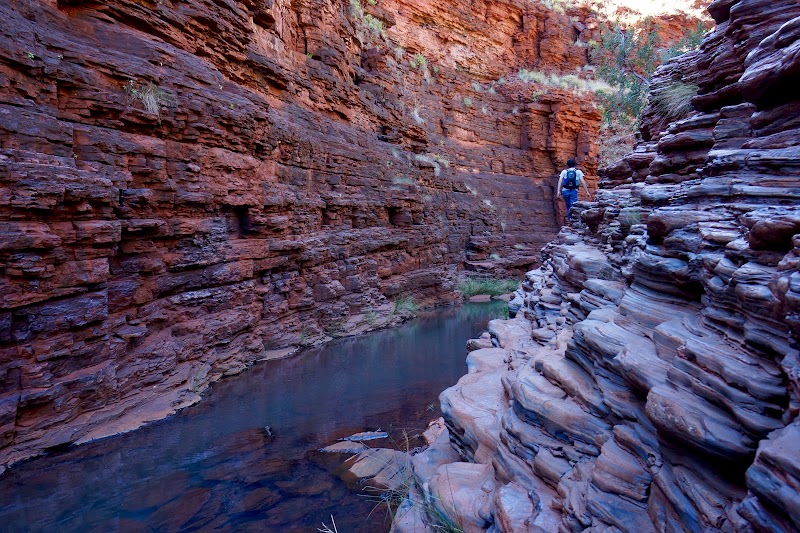Canyons and Crystal Pools: Exploring Karijini National Park’s Rugged Heart
Karijini National Park offers hikers a fierce encounter with dramatic gorges and tranquil natural pools just outside Tom Price, Western Australia. Discover rugged trails, cool water holes, and stunning views while learning practical tips to plan a safe, unforgettable adventure.
Start Early to Beat the Heat
Begin hikes early in the morning to avoid soaring temperatures and secure a good parking spot at popular trailheads.
Wear Sturdy Footwear
Trails can be rocky and uneven, with some scrambling sections. Strong hiking boots with good grip are necessary for safety.
Carry Ample Water
Bring at least 2 liters per person. Water refilling is scarce and unreliable, especially during warmer months.
Respect the Environment
Stick to marked trails to protect fragile vegetation and cultural sites. Take all rubbish with you to preserve the park’s delicate balance.
Canyons and Crystal Pools: Exploring Karijini National Park’s Rugged Heart
Karijini National Park near Tom Price in Western Australia challenges every visitor to walk alongside ancient gorges carved fiercely by time and water. The landscape is a raw interplay of rust-red cliffs and cool, inviting pools—each gorge a corridor to discovery, each natural pool daring you to pause and refresh beneath the stark sun.
Start your journey from the Karijini Visitor Centre just outside Tom Price, where maps and local advice gear you up for the trails ahead. The park’s network of walks offers options from quick glimpses to all-day treks; one standout is the Hancock Gorge trail, roughly 3km return with some scrambling and narrow rock passages that demand good footing and a steady pace. Expect elevation changes up to 100 meters, rewarding climbers with serene waterholes and the echo of cascading streams.
As you move through these dramatic gorges—Weano, Joffre, and Knox stand out among them—the rocky walls seem alive. Shadows play on the rough surfaces, and wind whistles, as if the landscape itself cautions respect: this place is fiercely itself, not to be rushed or underestimated. The terrain is rugged: sandstone scree, uneven paths, and occasional wet crossings require sturdy boots and a watchful eye.
Hydration is crucial. Carry at least two liters per person, more if hiking in warmer months. Water refilling points are limited and seasonal, so plan accordingly. Go early in the day to avoid the heat and secure parking, and bring swimwear if you want to dive into the tranquil pools that offer cool relief and unique photographic opportunities.
Beyond the physical, the park is a place of rich connections. Local Banyjima culture embeds deep meaning in the land, translating the twisting gorges and whispering waters into stories and tradition. Leave no trace: pack out all rubbish, tread lightly among plant life, and respect the natural features that have stood for millions of years.
Whether you’re a casual hiker or a more experienced adventurer, Karijini demands attentiveness but rewards with vast panoramic views, refreshing swims, and a sense of connection to a landscape that hasn’t softened with time. It’s a direct encounter with Western Australia’s outback edge—a test of resolve and a chance for renewal under a relentless yet captivating sky.
Nearby Trips
All Adventures
Boat Charters
Water Activities
Adventures near Tom Price
Discover the unique and memorable adventures that make Tom Price special.
Frequently Asked Questions
Are the gorges in Karijini National Park safe for beginner hikers?
While some trails are accessible for beginners, many gorge walks require moderate fitness and agility, especially Hancock Gorge with its narrow rock scrambles. Beginners should choose shorter, well-marked paths and avoid the more technical gorges without experience.
When is the best time of day to visit the pools for swimming?
Early morning or late afternoon visits are ideal. The pools are calmer and less crowded, and temperatures are more comfortable before midday heat or approaching dusk.
Is it necessary to have a guide to explore Karijini’s gorges?
It’s not mandatory, but hiring a local guide is recommended for first-time visitors to safely navigate more challenging routes and to gain cultural and ecological insights.
Are there facilities available inside the park?
Facilities are limited. Basic toilets and picnic areas exist near major carparks, but there are no shops or water taps beyond the visitor center, so bring all essentials with you.
Can dogs or pets be brought into Karijini National Park?
Pets are not allowed within the park to protect native wildlife and ecosystems.
What wildlife might I encounter while hiking in Karijini?
You may see rock wallabies, various bird species like the spinifex pigeon, and reptiles such as goannas. Observing quietly from a distance ensures a safe and respectful experience.
Recommended Gear
Sturdy Hiking Boots
Protection and grip on rocky, uneven terrain are critical for safe exploration of the gorges.
Hydration Pack or Bottles
Carrying sufficient water is vital, especially in summer or longer hikes with no water sources.
Quick-Dry Swimwear
Useful for cooling off in natural pools, especially in warmer months.
Wide-Brimmed Hat and Sunscreen
Protection against strong sun exposure is necessary to prevent burns and heatstroke.
Local Insights
Hidden Gems
- "Oxer Lookout for panoramic views of intersecting gorges"
- "Handrail Pool, a serene swimming spot accessible via a steep descent"
- "Honeycomb Gorge, less visited but notable for delicate rock formations"
Wildlife
- "Black-footed rock-wallabies"
- "Spinifex pigeons and other native birds"
- "Varied reptiles including thorny devils and lace monitors"
History
"The park lies on the traditional lands of the Banyjima, Kurrama, and Innawonga peoples, whose cultural stories encode the natural features and significance of the gorges."

